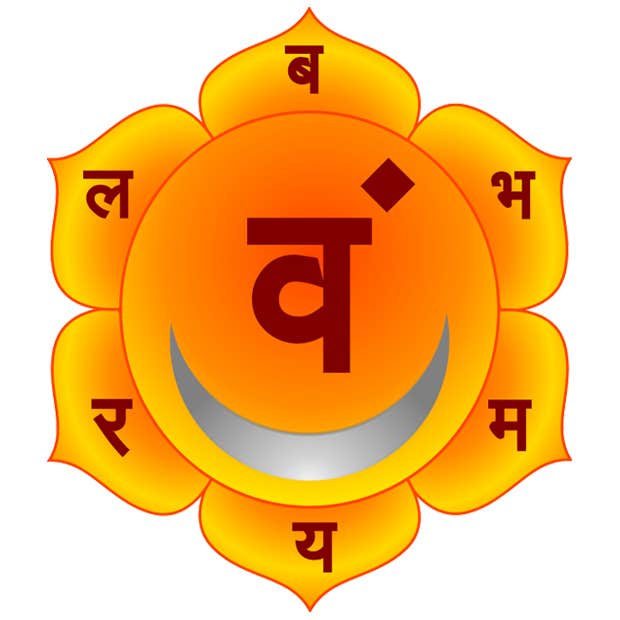What It Means If You Have A Blocked Sacral Chakra — And How To Open Yours
Your sacral chakra's superpower is creative expression and manifestation.
 GaudiLab / Shutterstock
GaudiLab / Shutterstock The concept of chakras first appeared in India around 1500 BC. They're believed to be energy points in your body, and when they're blocked, it can indicate health issues or even emotional problems.
Your chakras each have their own type of superpower. Some, like the second chakra, express themselves both negatively and positively.
Each chakra represents the lesson you’re here to learn. Therefore, you may need exercises to balance and open your second chakra, and engage in self-reflection about what it means for you.
What is the sacral chakra?
The second chakra, also known as your sacral chakra, is the sex, power, and money chakra. It’s located between the belly button and the genitals, and encompasses the whole area between those two points.
The second chakra teaches you how to honor each other and your own sexuality. It teaches you to make agreements with others that are mutually empowering. The sacral chakra is your creative center as well as your sex center.
The Sanskrit name for the second chakra is Svadhishthana. The chakra’s color is orange and the element is water.
 Photo: Mirzolot2, CC BY-SA 3.0 / Wikimedia Commons
Photo: Mirzolot2, CC BY-SA 3.0 / Wikimedia Commons
What does the sacral chakra represent?
The sacral chakra can be intensely emotional. While the color orange represents creativity and sexuality, the element of water is related to emotions; therefore, issues with the second chakra can lead to emotional problems.
As the sex, power, and money chakra, the sacral chakra teaches you how to move with your sexuality in the world in a way that is honoring to yourself and others. Your desires to create intimate relationships, pleasure, sensuality, and being nurtured come from the second chakra.
The second chakra is connected to sensuality and touch, the latter of which is a basic human need. Our sacral chakra is connected to learning how to touch in a respectful, healing way.
It's where you learn how to give and receive from one another in a way that is creative and life-affirming, instead of destructive. This includes the agreements you make with others regarding sex and money.
The sacral chakra awakens the power of creating partnerships. It’s how you relate to others outside your family of origin. It's the manifestation of relationships, the expression of your sexuality, and discovering your power of choice.
How do you know if your sacral chakra is blocked or imbalanced?
When blocked, your sacral chakra carries negative aspects.
Sexual repression, guilt, and shame are all negative expressions of the second chakra. Having disempowering sexual experiences is a negative expression of the second chakra.
Using people for your own advantage, using sex to manipulate or control, and giving sex to get something are all negative expressions of the second chakra.
Narcissism, lust, attention-seeking behavior, addiction to sensual pleasure, and addiction to pornography are all signs of an unbalanced sacral chakra.
Additionally, one can suffer from an overactive sacral chakra. An overactive sacral chakra means distributing too much energy throughout the body. This overactive energy creates an overwhelming feeling within and can create addictive behaviors.
What causes a blocked sacral chakra?
The biggest cause of a blocked sacral chakra is repression, suppression, and/or fear. It is when your natural flow of energy is forcibly stopped.
Most societal cultures teach sexuality and sex as taboo subjects since childhood. This can cause people to build up boundaries that inhibit the energy flow within us as human beings.
It instills a belief that our pleasure, joy, creative energy, and sexual energy are wrong when, in reality, it is a beautiful and natural act of life.
How do you know if your sacral chakra is healthy and balanced?
Your sacral chakra's "superpower" is creative expression and manifestation. A positive expression of the second chakra is when you're resourceful, resilient, and express your natural talents.
This chakra is connected to your ability to birth something into the world, whether that is a healthy, welcomed, well-prepared-for baby, or a creative project you're passionate about.
Having a positive attitude about sex and a healthy relationship with money are positive expressions of a healthy second chakra. It's also connected to your ability to nurture yourself and others.
Strong survival instincts, perseverance, healthy sexuality, sensuality, financial acumen, and a willingness to take risks are all signs of a healthy, well-balanced sacral chakra.
How To Open & Unblock Your Sacral Chakra
1. Try a pelvic rocking exercise.
Pelvic rocking is an exercise that not only strengthens your hips and back, but can help open your sacral chakra.
Lie down on your back with your legs bent and feet on the floor. Slowly begin to tilt your pelvis upward and downward.
As you inhale, tilt your pelvis down, arch your back, and fill your belly up with breath. As you exhale, tilt your pelvis up, press your lower back into the ground, and squeeze your pelvic floor muscle, pulling the energy in and up from the bottom of your body.
Continue rocking on your pelvis in this way to bring energy into your second chakra and up the spine, igniting your creativity.
You can do this exercise with music. Fast-paced, rhythmic, tribal drumming music is perfect. Do this for up to 20 minutes and then rest on your back. Feel the sensations you have cultivated.
You can also add gemstones to your practice. Coral and carnelian are great gemstones to open up this chakra, and you can use essential oils as well.
2. Do yoga.
There are certain yoga poses, or asanas, that will help balance and open up your sacral chakra. Certain poses work to open your hips, back, and pelvis, and doing so can subsequently open your sacral chakra.
A few of these poses include Goddess Pose, Warrior II, Reverse Warrior, Wide-Legged Forward Bend, Seated Forward Bend, Pigeon Pose, and Bound Angle Pose.
3. Participate in dance medicine.
Our culture holds sexual shame, and the female body consciously or unconsciously has not been given a safe space to express itself. Therefore, many women are sexually and sensually inhibited. Many suffer from sexual health issues or think there's something wrong with their sexuality.
The truth is, female sexuality hasn’t been supported or celebrated in our culture.
Dance medicine, where you move your body — especially your hips — provides much-needed medicine to heal the cultural shame you've been born into. Dance allows you to express the full creative potential that lies within you and your pelvic bowl in the privacy of your own home.
4. Add more orange to your life.
You can balance the sacral chakra by eating orange foods. Some of the best foods include sweet potatoes, carrots, mango, oranges, orange peppers, peaches, and apricots.
Also consider wearing more orange, both inside and outside your home, and, overall, be mindful of the color orange, being sure to visualize it in and around your body.
5. Practice self-reflection.
It's important to spend time self-reflecting while you do exercises to open your sacral chakra.
Close your eyes and ask yourself the following questions:
- Do you express your creativity in positive ways?
- Are you struggling with issues related to sex, power, and money?
- Do you use your sexuality (your power or your money) to manipulate or control others?
- Are you living an authentic expression of yourself?
- Do you have a positive, respectful, and honoring attitude about sex?
Opening your sacral chakra will help you in many areas of your life. Practice these simple exercises and watch your life change.
Anna-Thea is an author and Certified Divine Feminine Educator. She educates people on how to claim their bodies as sacred. If you’d like to open and balance your chakras, check out her Guided Chakra Meditation for beginners.

